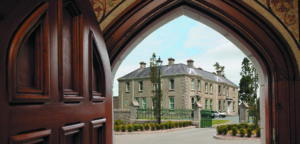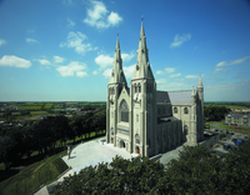of the
Church of the Immaculate Conception of the Blessed Virgin Mary, Beragh
29 July 2009
Address by
Cardinal Seán Brady
I am very pleased to be here in Beragh to celebrate 25 years of your Church of the Immaculate Conception of the Blessed Virgin Mary. I thank Fr McAnerney and the Parish for the invitation to do so. It is a great sign when a parish wishes to celebrate something like this.
Fr Arty says the Church has been very satisfactory and much appreciated by the people. This celebration is proof of that.
In 1984, the late Fr Quigley, and Fr Peter McParland, who was then curate here, thanked you, the parishioners, who over the previous two years had sacrificed much time and effort to make the new church a reality. At that time Cardinal Ó Fiaich noted that it took a short time to build this church, less than a year and that it was virtually paid for on the day it opened. He described that as a monument to your faith. He expressed the hope that you would return here often to celebrate the sacraments with your families and friends.
It has been my privilege and joy to come here and celebrate the Sacrament of Confirmation with you, on many occasions, during fifteen of these past twenty-five years. Of course I have come for other less happy occasions too, such as funerals. While these were definitely very sad occasions, they were also occasions that were filled with hope, despite the sadness. They were filled with hope because they put us in contact with Jesus Christ, who died, but who rose from the dead, and who promised that we will rise from the dead, despite our dying. There were also occasions when our celebrations in this church were extended with some refreshments in the Hall and these were also memorable and happy occasions.
One of the Confirmations I remember best was an evening when the late, lamented, Fr Frank Quigley was sitting to my left. Somehow or other he began to feel that the response from you, the congregation, was not as enthusiastic as he would have wished. So he began to gesticulate, like the conduction of an orchestra, urging us all, I suppose, to become more involved. When I think of it, perhaps we all are sometimes inclined to be over casual and relaxed in our response to God’s Word to us. Well our ancestors certainly did not take the arrival of God’s Word into their ears and hearts too casually. Fr McAnerney has kindly supplied me with some notes on the history of Christianity in this area and I find them very helpful.
I find it very interesting that the oldest religious site in this parish is at Donaghanie. There, St Patrick is said to have founded a monastery. Now, I want you to think about this for a moment.
Patrick founded a monastery because there was a demand for a monastery, because there was need for a monastery. Some people from here were obviously asking for this monastery. Remember, at this stage there were no Christian Churches, or parishes, or dioceses, but obviously there were people who, once they heard the Message brought by Patrick, thought, “this is exciting stuff, this is important, this could give some sense to my life, give new hope to my existence.” I want you to give more time to this, to think about all of this. Of course words like those we have just heard in the Gospel are fairly heady stuff. “You did not choose me, I chose you and appointed you to go and bear fruit, the kind of fruit that endures.”
The people who flocked to Patrick at Donaghanie from places like Clogherny Upper and Clogherny Lower, Drumduff, Roscavey and Seskinore, must have had the deep conviction that they too were being called to a big undertaking.
Nowadays when you hear of someone entering a monastery you may have visions of them being cut off from family and community, and there always has been that side to it. But, in the days of Patrick, obviously people entered monasteries to find out more, and to better understand, what God’s plan for them was and to put those plans into action. That is why monasteries very soon became great centres of learning and centres of excellence. They were also sometimes centres of healthcare and hospitality, for the sick, for the poor and for the traveller. They were there to change the society of the day, into a better society. And so you see the Monks stepped aside from the bustle of life because they knew they had found the pearl of great price in Christ. They wanted to get to know Christ, at all costs, and so they were prepared to leave all behind to take on this utterly important work. They went aside to the monasteries and their lives bore much fruit, and without them we would not be here today, doing what we are doing.
Far from the monasteries I imagine missionaries went out to the rest of the countryside bringing the Good News that the Kingdom of God was near and calling people to repent of their sins and to believe the Good News.
It is interesting to notice that the next item to be seen is the notes on the history of the Church of the Parish of Beragh is that Donaghanie was, for many years, a place of pilgrimage. There large crowds used to assemble on the first Sunday of August to do certain penances down through the centuries. It is a feature of the life of the followers of Christ that when we hear the Good News, when we find the pearl of great price, Christ; we are prepared to sacrifice everything in order to grow in friendship with Christ. This involves examining our lives honestly and seeing in what direction we are headed. It involves recognising the fact that we are sinners. It means repenting of those sins, confessing them and doing penance for them.
The next item of history worth recalling is that throughout the dark century of the Penal Laws, Mass was celebrated at a number of altar stations or Mass Rocks in this parish. There is evidence that there were two in Clogherny and one in Drumduff. The sites were marked on the ordinance survey map as Mass Hills.
Then there was the murder of the Parish Priest, Father Henry Corr. This foul deed is said to have taken place sometime before the year 1800 either in the townland of Roscavey or Deroaran.
There could be a temptation to note these events as historical facts without pondering their deeper meaning.
Again what is the lesson? Just consider that these were your ancestors – your great-great grandparents who were prepared to make such huge sacrifices in order to be able to assist at the celebration of Mass on windswept hillsides – in hail, rain, sleet and snow. They knew that it was the Mass that mattered. They had heard the words of Christ and put their trust in them. Words like these:
I am the Bread of life
Those who come to me will never be hungry.
Those who believe in me will never be thirsty.
I will never turn away anyone that comes to me.
If you do not eat the flesh of the Son of Man and drink His Blood
You will not have life in yourselves…
Those who eat my flesh and drink my blood live in me and I live in them.
Those who eat this bread will live forever.
The building of Beragh Chapel began in 1800 and was dedicated by Archbishop Curtis sometime between 1819 and 1832. In 1834 it was described as crowded despite the fact that it could accommodate about 1,000 persons. This was probably the decisive factor in the decision of Father Bernard McAleer (1834-37) to build chapels in Seskinore and Drumduff. Then, of course, Mass has been celebrated in the Oratory attached to the Parochial House since 1926.
Again, what conclusions can we come to out of all of this? Here we have a people who put a lot of value on coming together to hear the Message of the Lord and to pray and praise God – to receive His pardon – to be fed and strengthened with the Bread of Life – the Body of Christ.
It is a people that get their strength to go out and work to build up the kind of community that the Kingdom of God is meant to be. A community built on justice and fair play – on honesty and truth – as the only basis for real peace and genuine harmony.
There are big lessons for all of us as we try to heed those values about building up God’s community in an age where the loudest message often seems to be – Everyone for himself and to hell with the community.



You must be logged in to post a comment.